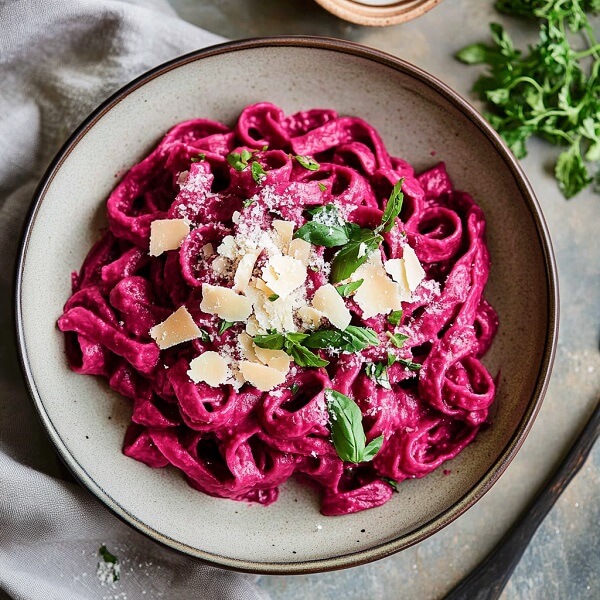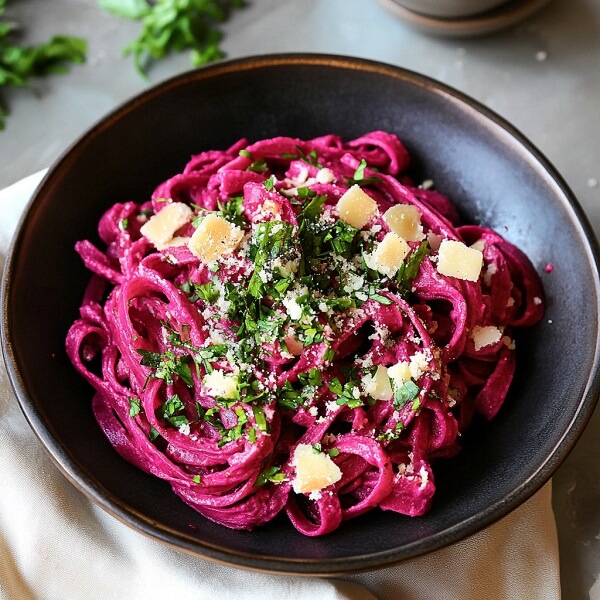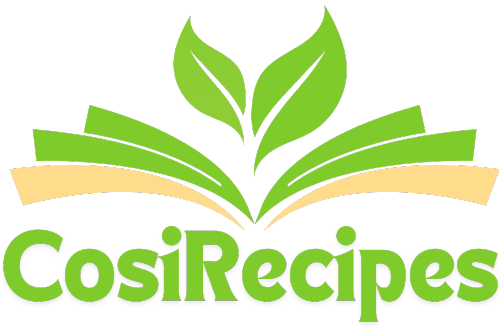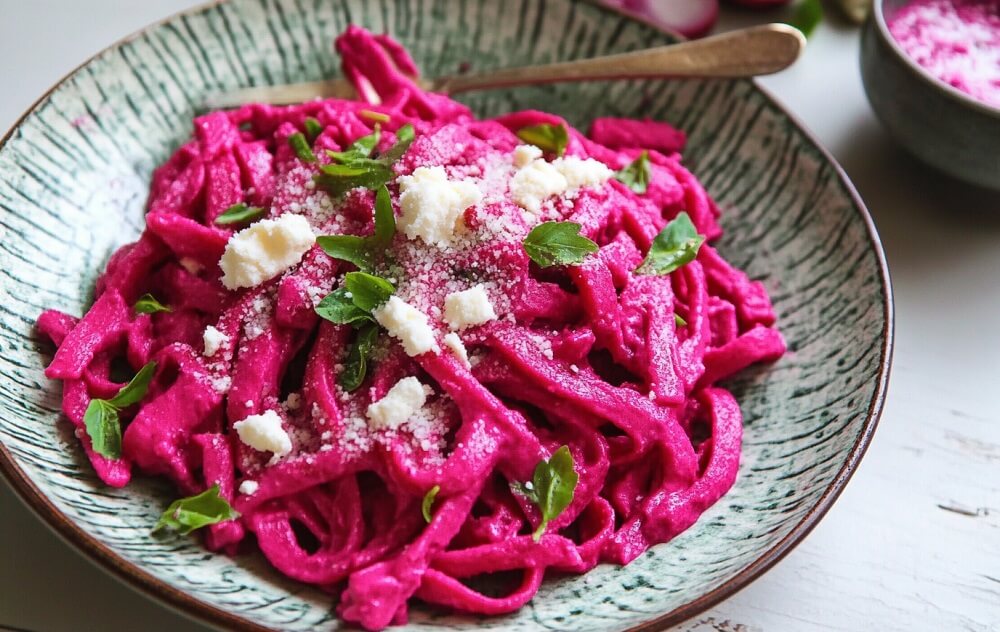Beetroot pasta has emerged as a vibrant and nutritious culinary trend, celebrated for its striking color, rich flavor, and health benefits. This unique pasta incorporates beetroot, a versatile root vegetable known for its earthy sweetness and nutritional value.
Why is Beetroot Pasta Gaining Popularity?
- Health Benefits: Beetroot pasta is rich in essential nutrients like vitamins, antioxidants, and dietary fiber, making it a healthier alternative to traditional pasta.
- Visual Appeal: The natural, vibrant pink hue of beetroot pasta adds a gourmet touch to any dish, making it visually stunning.
- Unique Flavor Profile: Its mild, earthy sweetness complements a variety of sauces, from creamy garlic to tangy citrus-based ones.
In this article, we’ll explore the ingredients, step-by-step process of making beetroot pasta, its health benefits, and the most popular recipes. Whether you’re a foodie or a health enthusiast, this guide will inspire you to bring beetroot pasta to your table.
2. What is Beetroot Pasta?
Beetroot pasta is a unique twist on traditional pasta, made by incorporating beetroot purée or juice into the pasta dough. It’s celebrated for its vibrant color and nutrient-packed profile.
Description and Origin
- Beetroot pasta combines classic Italian pasta-making techniques with a creative use of beets to enhance both aesthetics and flavor.
- While the exact origin of beet pasta is unclear, its rise to fame is tied to the growing demand for plant-based and visually appealing meals.
Differentiating Beet Pasta Dough from Beet Pasta Sauce
- Beet Pasta Dough: Made by mixing beetroot purée with flour and eggs to create a colorful and nutritious dough.
- Beet Pasta Sauce: Uses blended cooked beetroot to create a creamy, flavorful sauce that coats traditional or beet-based pasta.
This fusion of color, taste, and health benefits has made beetroot pasta a favorite among home cooks and chefs alike.
3. Ingredients for Beetroot Pasta

Crafting beetroot pasta begins with simple yet versatile ingredients that blend together to create a visually stunning and delicious dough. Here’s a breakdown of the essential components and optional enhancers.
Basic Dough Ingredients
1. Flour Types
Choosing the right flour is crucial for achieving the desired texture in your pasta dough. Common options include:
- 00 Flour: Known for its fine texture, 00 flour creates smooth, elastic dough, ideal for pasta-making.
- Semolina Flour: Adds a slightly grainy texture and firmness to the pasta, perfect for shaping pasta like fettuccine or tagliatelle.
- All-Purpose Flour: A more accessible option, suitable for beginners, though it may result in a slightly less refined texture.
2. Eggs
Eggs provide structure and richness to the pasta dough. Variations include:
- Whole Eggs: Offer a balance of protein and fat, resulting in a rich, supple dough.
- Egg Yolks: Yield a richer and more golden-colored dough, often used in gourmet pasta recipes.
3. Beetroot
Beetroot is the star ingredient that gives this pasta its vibrant color and subtle sweetness. Options include:
- Raw Beetroot: Grated or puréed, it provides maximum freshness and flavor.
- Cooked Beetroot: Soft and easier to blend into a smooth purée.
- Beetroot Purée: A pre-prepared, time-saving option available in stores or made at home.
Optional Enhancers
1. Olive Oil
Adding a teaspoon of olive oil enhances elasticity, making the dough easier to work with.
2. Salt
A pinch of salt brings out the natural flavors of the beetroot and balances the dough’s sweetness.
3. Herbs for Added Flavor
Incorporating fresh or dried herbs like basil, thyme, or parsley can infuse the dough with subtle aromatic notes.
Comparison of Ingredient Ratios from Top Recipes
To achieve the perfect beetroot pasta dough, understanding ingredient ratios is key. Here’s an example:
- From The Burnt Butter Table:
- 2 large eggs
- 135g beetroot (puréed)
- 400g flour
This combination ensures the dough is firm yet pliable, with the beetroot providing a vibrant color and mild sweetness.
Pro Tip
Adjust the flour quantity based on the moisture content of your beetroot purée. Start with less flour and gradually add more to reach the ideal dough consistency.
4. How to Make Beetroot Pasta at Home (Step-by-Step)

Making the Dough
Step 1: Blending or Puréeing Beetroot
- Start with cooked or raw beetroot. Cooked beetroot is softer and easier to blend.
- Blend the beetroot into a smooth purée using a blender or food processor. Aim for a thick, lump-free texture.
- Pro Tip: If the purée seems too dry, add a tablespoon of water. If too wet, strain it with a fine mesh sieve.
Step 2: Mixing Wet and Dry Ingredients
- Combine Dry Ingredients:
- Place 2 cups of flour (00, semolina, or all-purpose) on a clean work surface or in a bowl.
- Create a well in the center.
- Incorporate Wet Ingredients:
- Add 2 eggs and 1/2 cup of beetroot purée to the well.
- Sprinkle a pinch of salt for flavor.
- Mix and Knead:
- Gradually incorporate the flour into the beetroot mixture using a fork or your hands.
- Knead the dough for 8–10 minutes until it becomes smooth and elastic.
- Wrap the dough in plastic wrap and let it rest for 30 minutes.
Shaping the Pasta
Step 1: Rolling Out the Dough
- Divide the dough into smaller portions to make it easier to work with.
- Roll each portion out thinly using a rolling pin or a pasta machine. Aim for uniform thickness.
Step 2: Cutting Shapes
- Fettuccine or Tagliatelle: Use a sharp knife or pasta cutter to slice the dough into thin, even strips.
- Ravioli: Use a cookie cutter to create circular shapes, then fill with your favorite stuffing.
- Pro Tip: Dust the pasta lightly with flour to prevent sticking.
Cooking the Pasta
Step 1: Boiling
- Bring a pot of salted water to a boil.
- Add the beetroot pasta and cook for 2–4 minutes, depending on its thickness. Fresh pasta cooks faster than dried.
Step 2: Retaining Color
- Add a splash of lemon juice or vinegar to the boiling water to preserve the pasta’s vibrant color.
Tips for Beginners
- Start with simple shapes like fettuccine before attempting more intricate ones.
- Practice makes perfect—don’t worry if your first batch isn’t flawless!
5. Health Benefits
Beetroot pasta is not just a feast for the eyes but also a nutritional powerhouse. Here’s why it’s a healthy choice:
1. High Nutritional Value
- Beetroot is packed with vitamins A, C, and B6, along with essential minerals like iron, magnesium, and potassium.
- It’s rich in antioxidants, such as betalains, which help reduce inflammation and support heart health.
2. Low-Calorie and Gluten-Free Variations
- Using beetroot as a base reduces the need for high-calorie sauces, making it a lighter option.
- Gluten-free versions can be made using alternative flours like almond or chickpea flour, catering to those with dietary restrictions.
3. Comparing Beet Pasta to Traditional Pasta
- Higher Fiber Content: Beetroot adds natural fiber, aiding digestion and keeping you full for longer.
- Rich in Minerals: Traditional pasta lacks the nutrient density found in beetroot pasta, particularly its iron and potassium content.
Beetroot pasta combines nutrition with aesthetics, making it a fantastic choice for health-conscious individuals and food enthusiasts alike!
6. Common Variations of Beetroot Pasta
Beetroot pasta is incredibly versatile, with adaptations to suit various dietary preferences and taste profiles. Here are some popular variations:
Vegan Pasta
- Replace eggs with water, a touch of olive oil, or aquafaba (chickpea water) to create a fully vegan version.
- Use semolina or all-purpose flour with beetroot purée for a vibrant and delicious dough.
Creamy Pasta with Cheese-Based Sauces
- Pair beet pasta with creamy sauces like a mix of Parmesan, cream cheese, and garlic. The richness balances the earthy sweetness of the beetroot.
- Add fresh herbs like thyme or parsley for added flavor.
Gluten-Free Beet Pasta with Alternative Flours
- Use almond flour, chickpea flour, or a gluten-free flour mix to make the pasta dough.
- Combine the gluten-free flour with beetroot purée and a binder like xanthan gum for structure.
Popular Recipes
- Creamy Beet Pasta with Garlic:
- Toss beetroot pasta in a sauce made from puréed beetroot, garlic, and cottage cheese for a creamy texture and tangy flavor.
- Blender Beet Pasta(Inspired by Nadiya Hussain):
- Blend cooked beetroot with olive oil, garlic, and spices to make a quick and flavorful sauce for your beet pasta.
7. FAQs
How is Beetroot Pasta Different from Regular Pasta?
- Beetroot pasta stands out due to its vibrant pink-red color and subtle earthy sweetness, unlike the neutral flavor of regular pasta.
- It’s also more nutritious, packed with antioxidants, fiber, and essential vitamins.
What Type of Beetroot is Best for Pasta?
- Both raw and cooked beetroot work well, but cooked beetroot is easier to blend into a smooth purée.
- Use fresh, firm beets for the best flavor and vibrant color.
Can Beetroot Pasta Be Made Without Eggs?
- Yes! Vegan alternatives include substituting eggs with water, olive oil, or aquafaba to maintain the dough’s consistency.
How Do You Store Beetroot Pasta?
- Fresh Pasta: Dust with flour and store in an airtight container in the refrigerator for up to 2 days.
- Cooked Pasta: Keep in an airtight container in the refrigerator for up to 3 days. Reheat gently to avoid drying out.
- Freezing: Freeze fresh pasta in portions, ensuring it’s well-floured to prevent sticking.
What Does Beetroot Pasta Taste Like?
- Beetroot pasta has a mildly sweet and earthy flavor that complements creamy and tangy sauces. It’s less starchy than traditional pasta, offering a lighter taste.






